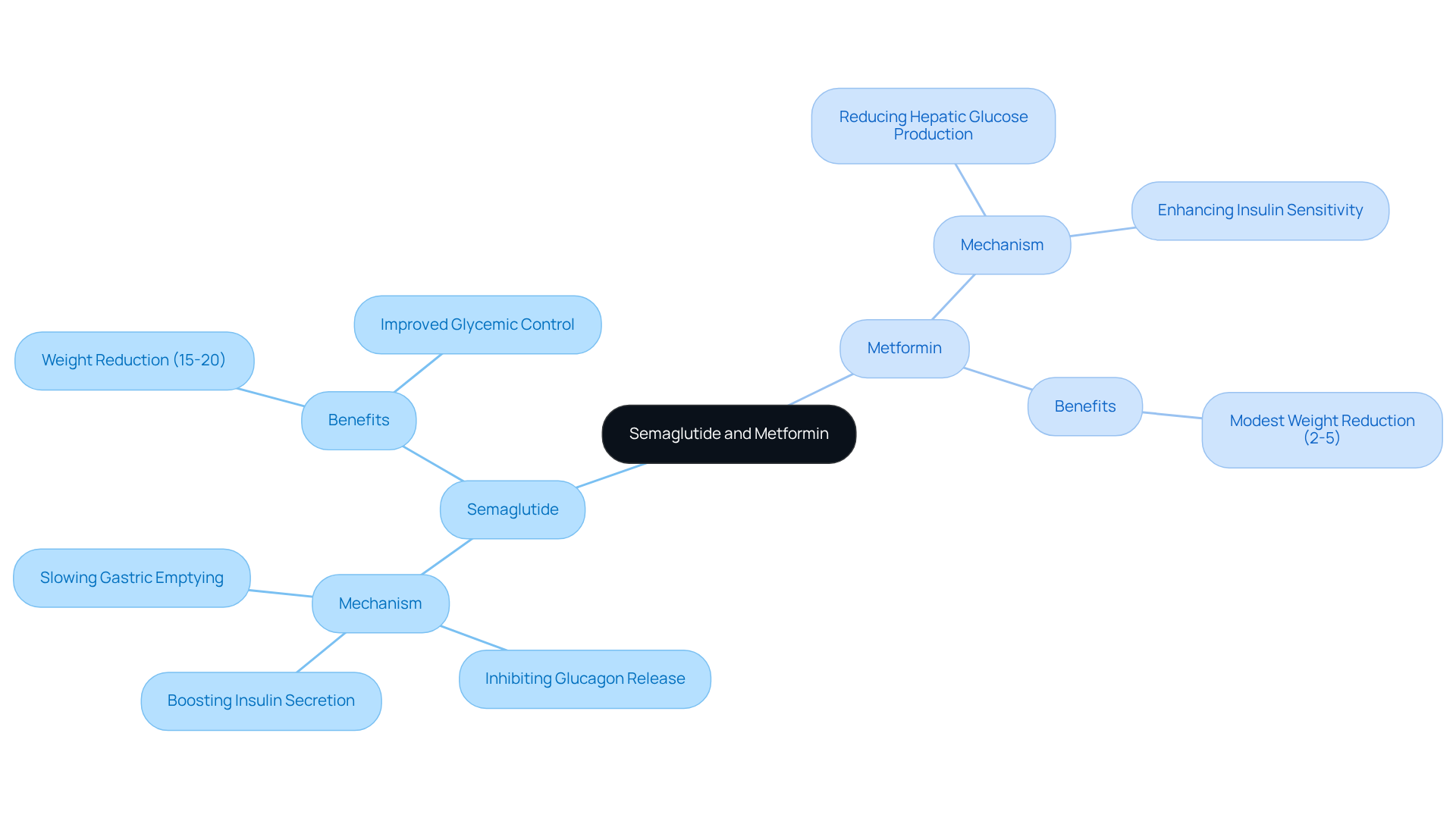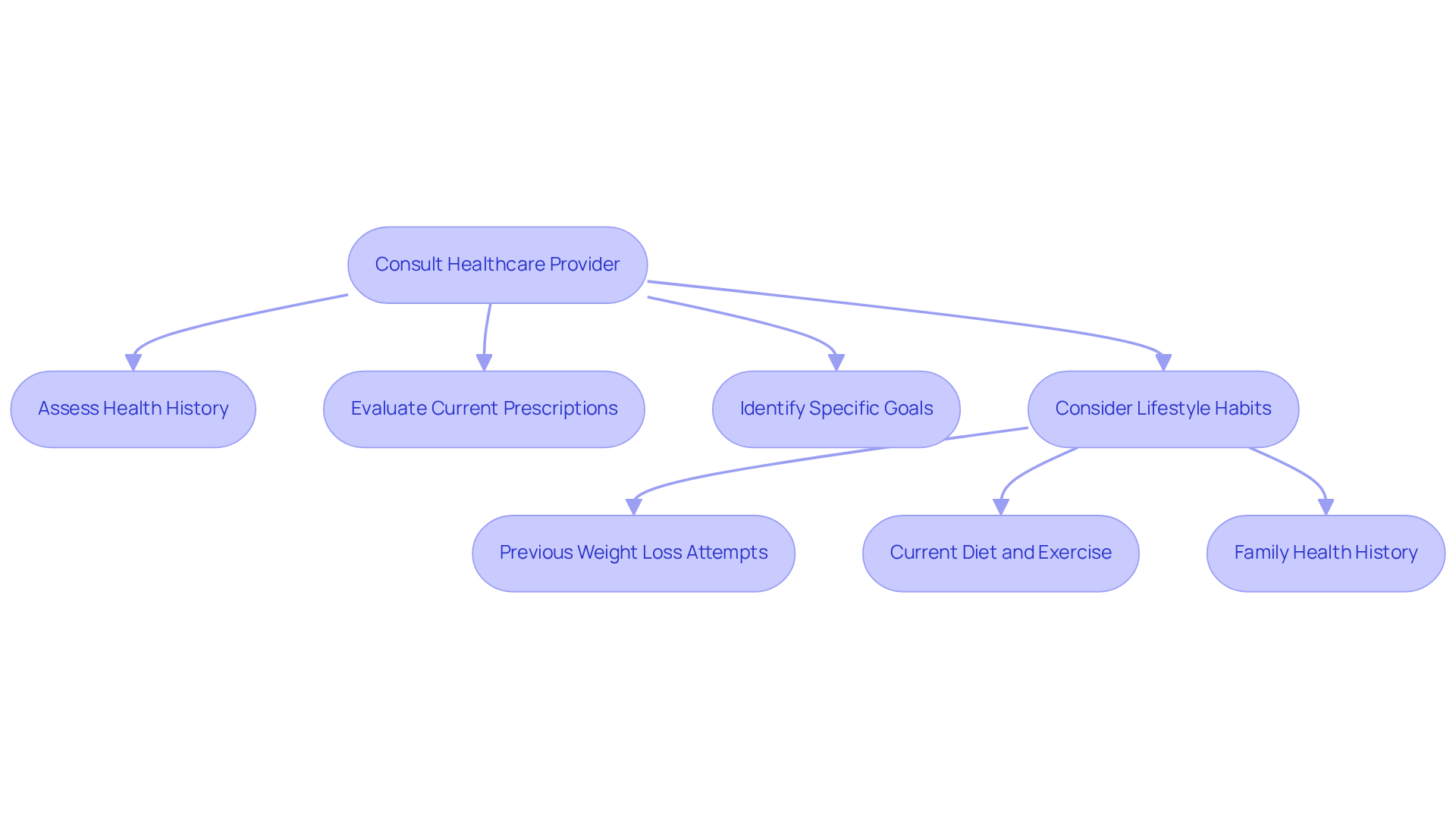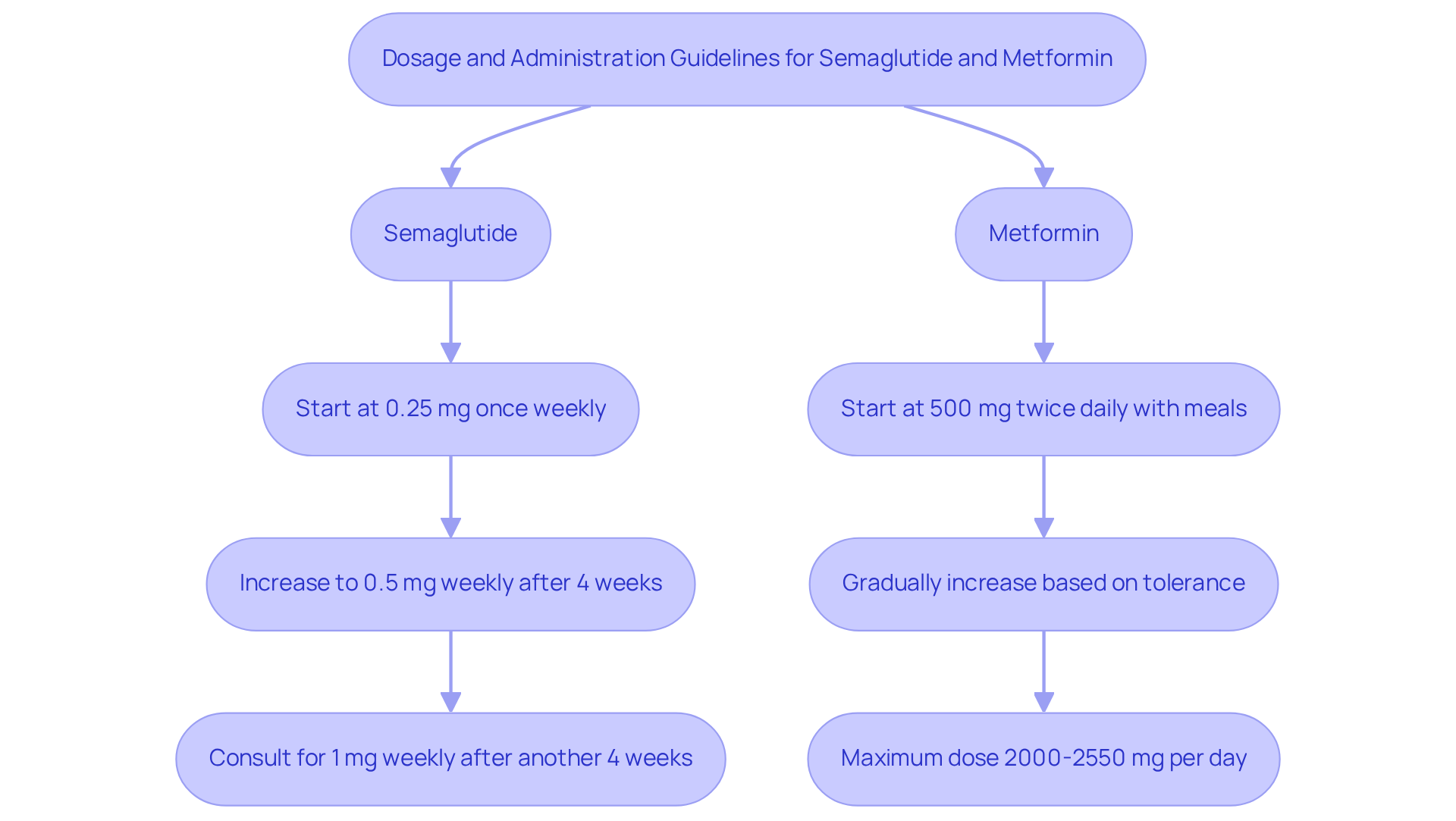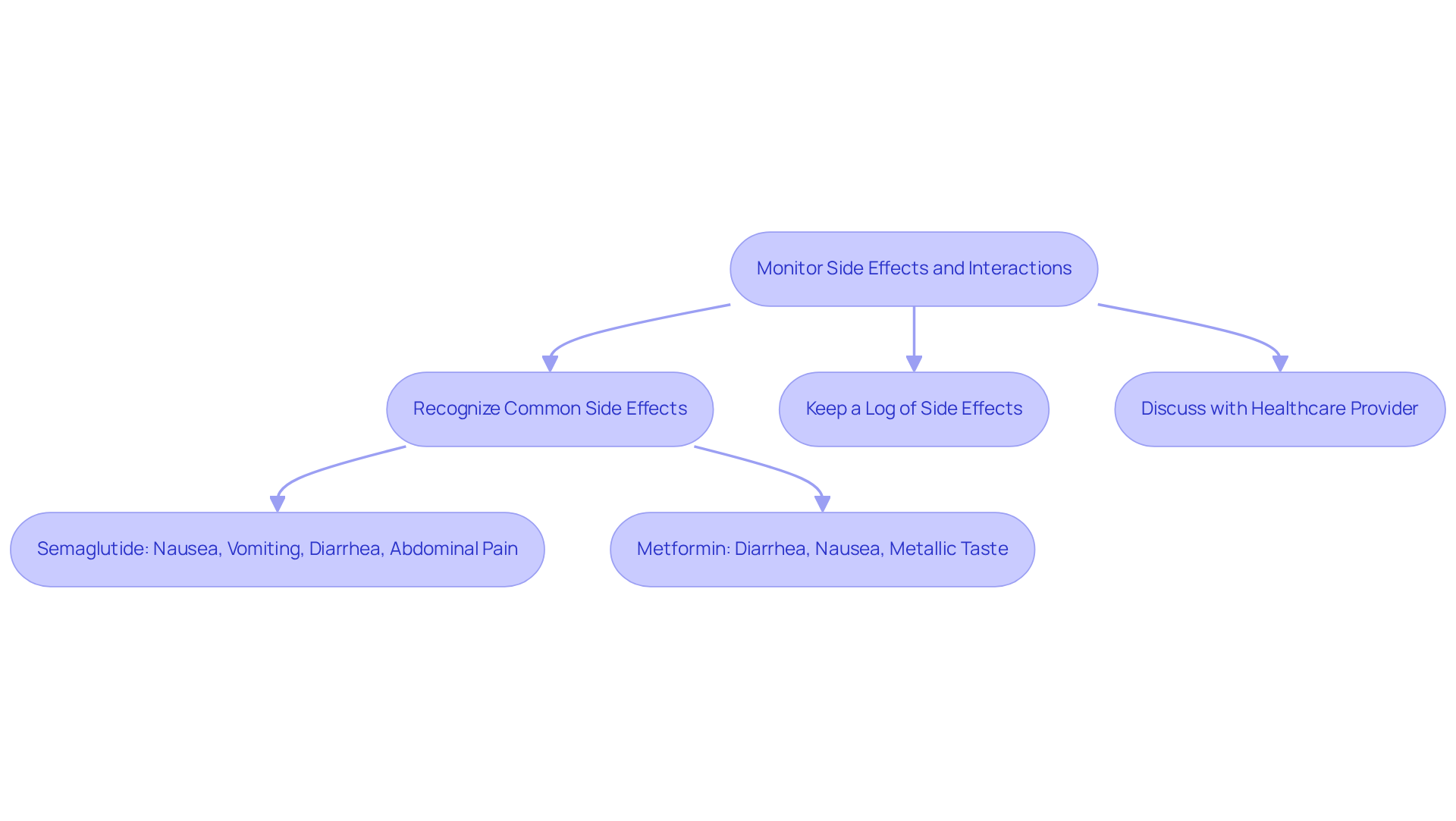Overview
This article explores the compassionate approach to using semaglutide and metformin together for weight loss. If you’re feeling overwhelmed by your weight loss journey, know that you’re not alone. This combination can lead to significant reductions in body mass while also improving glycemic control, offering hope and support for those managing obesity and type 2 diabetes.
Clinical evidence shows that semaglutide can yield an impressive average weight loss of 15-20%. When paired with metformin, it enhances overall metabolic health, making it particularly beneficial for individuals like you who are striving for better health outcomes. Together, we can achieve your goals and improve your quality of life.
We understand how challenging it can be to navigate these changes, but with the right support and information, you can take meaningful steps towards a healthier future. Remember, you’re not in this alone; we’re here for you every step of the way.
Introduction
Managing obesity and type 2 diabetes can feel like an uphill battle for many individuals, often requiring a multifaceted approach to achieve lasting results. It’s understandable to feel overwhelmed by the journey ahead. The combination of semaglutide and metformin has emerged as a promising strategy, offering not only potential weight loss but also improved metabolic health. Yet, as you consider this approach, an important question arises: how can you safely navigate the complexities of using these medications together to maximize their benefits while minimizing potential risks?
Together, we can explore this path with compassion and understanding. It’s essential to recognize that you are not alone in this journey. Many have found success by carefully managing their treatment plans, and with the right support, you can too. By focusing on both physical health and emotional well-being, we can work towards achieving your goals in a safe and effective manner.
Understand Semaglutide and Metformin: Mechanisms and Benefits
Managing type 2 diabetes and obesity can feel overwhelming, but we’re here to help. At Minimal, we tailor a strategy that incorporates semaglutide and metformin together as essential tools in a comprehensive plan for reducing body mass. Semaglutide, a GLP-1 receptor agonist, works by boosting insulin secretion, inhibiting glucagon release, and slowing gastric emptying. Together, these actions can help reduce appetite and promote fat loss. Clinical studies have shown that semaglutide can lead to significant weight reduction, with participants achieving an average decrease of 15-20% of their body mass over a year.
On the other hand, metformin primarily reduces hepatic glucose production and enhances insulin sensitivity, resulting in a modest reduction of 2-5%. When semaglutide and metformin together are used, they create a powerful synergy, improving glycemic control and enabling greater weight loss than either treatment alone. This combination is particularly beneficial for those who are struggling with both obesity and type 2 diabetes, as it effectively addresses both weight management and blood sugar regulation.
At Minimal, we believe in a holistic approach to health. We integrate these medications with personalized fitness and nutrition guidance to support your journey. Case studies have demonstrated the effectiveness of GLP-1 receptor agonists like semaglutide in clinical settings, with patients experiencing significant reductions in body mass. For instance, a cohort study revealed that individuals receiving this medication achieved an average reduction of 12.3 kg (10.9%) at six months, showcasing its real-world efficacy.
Moreover, using semaglutide and metformin together not only aids in weight loss but also enhances overall metabolic health. This makes it an appealing choice for those seeking comprehensive management of obesity and diabetes. As Dr. Andres Acosta noted, further research with larger sample sizes and longer follow-up durations is essential to validate the effectiveness of these medications. Together, we can achieve your goals and foster a healthier future.
Consult Healthcare Providers: Assessing Individual Needs
Before starting semaglutide and metformin together, it’s essential to consult with a healthcare provider who understands the holistic approach offered by Minimal. This consultation is more than just a routine check; it involves a comprehensive assessment of your health history, current prescriptions, and specific goals for reducing body mass. At Minimal, we focus on tailored coaching that evaluates key elements such as your body mass index (BMI), existing health issues—like diabetes or cardiovascular concerns—and any possible contraindications for treatments. Additionally, we provide fitness training and nutrition guidance as part of our comprehensive support.
During this consultation, consider reflecting on:
- Any previous weight loss attempts and their outcomes.
- Your current lifestyle habits, including diet and exercise.
- Any side effects you’ve experienced from prior treatments.
- Your family history of diabetes or metabolic disorders.
This thorough assessment will empower your healthcare provider at Minimal to determine the most appropriate treatment plan tailored to your needs. It’s all about ensuring your safety and effectiveness while supporting your health journey. Remember, you’re not alone in this; together, we can achieve your goals. For additional support, feel free to connect with Minimal by phone at (872) 228 – 2358 or via email at [email protected].
Combine Semaglutide and Metformin: Dosage and Administration Guidelines
Using semaglutide and metformin together can be a transformative step in your weight loss journey, but it requires careful adherence to prescribed dosages to optimize benefits while minimizing potential risks. Let’s explore some essential guidelines for effective use, keeping your well-being in mind.
Semaglutide:
Start your treatment with a gentle dose of 0.25 mg once weekly for the first four weeks. This initial phase allows your body to acclimate to the medication. After this period, you can increase the dose to 0.5 mg weekly. If you’re looking for additional weight loss or improved glycemic control, your healthcare provider may suggest an increase to 1 mg weekly after another four weeks.
Metformin:
The standard starting dose is 500 mg taken orally twice daily with meals. This approach helps mitigate any gastrointestinal side effects. Metformin is FDA-approved for managing blood sugar levels in adults with type 2 diabetes and is often prescribed off-label for weight management. It enhances insulin sensitivity, curbs cravings, reduces the risk of heart disease, and improves long-term A1C levels. Based on your individual tolerance and blood sugar levels, the dosage can be gradually increased to a maximum of 2000-2550 mg per day, divided into two or three doses.
Administration Tips:
Semaglutide is administered via subcutaneous injection, typically in the abdomen, thigh, or upper arm. Remember to rotate your injection sites to prevent irritation. Metformin should always be taken with food to reduce the likelihood of gastrointestinal discomfort, which may include symptoms such as nausea or diarrhea.
Consultation and Monitoring:
It’s crucial to consult with your healthcare provider before making any changes to your medication regimen. They can offer personalized guidance and monitoring tailored to your needs. According to the FDA Drug Label, no clinically significant drug-drug interaction with this medication was observed, reinforcing the safety of using semaglutide and metformin together. Adhering to your healthcare provider’s specific instructions regarding dosage adjustments and administration techniques is vital for achieving optimal results. Research shows that individuals utilizing this medication can attain an average reduction in weight of 15% over a year and a half. This underscores the efficacy of using semaglutide and metformin together as a combination therapy. However, be mindful of potential side effects, particularly gastrointestinal issues, which may occur with this medication. Together, we can navigate this journey towards better health.
Monitor Side Effects and Interactions: Safety Considerations
While using semaglutide and metformin together is generally safe, it’s essential to monitor for potential side effects and drug interactions. Understanding what to expect can help you feel more at ease during your treatment journey. Common side effects include:
- Semaglutide: Nausea, vomiting, diarrhea, and abdominal pain. These symptoms are usually mild and tend to decrease over time, but we want you to be aware of them.
- Metformin: Gastrointestinal issues such as diarrhea, nausea, and a metallic taste in the mouth. It’s important to note that Metformin is not FDA-approved specifically for reducing body mass; its primary indication is for controlling blood sugar levels in individuals with type 2 diabetes. However, healthcare providers may prescribe it off-label for weight loss in certain cases. Rarely, Metformin can cause lactic acidosis, a serious condition that requires immediate medical attention.
To ensure your safety, consider keeping a log of any side effects you experience. Discuss these with your healthcare provider during follow-up appointments. Are you aware of potential interactions with other drugs? Especially those that influence blood sugar levels, like insulin or sulfonylureas? It’s crucial to stay informed, as using semaglutide and metformin together may increase the risk of hypoglycemia.
Regularly monitoring your blood glucose levels as advised by your healthcare provider can help assess the effectiveness of your treatment and make necessary adjustments. Remember, you’re not alone in this journey.
If you experience severe side effects or symptoms such as persistent abdominal pain, dizziness, or signs of an allergic reaction (like rash or difficulty breathing), please seek medical attention immediately. Together, we can navigate this path toward better health.
Conclusion
Using semaglutide and metformin together offers a hopeful path for those seeking effective weight loss and managing type 2 diabetes. This combination not only promotes weight reduction through their synergistic effects but also enhances overall metabolic health. By understanding how each medication works, you can harness their benefits to achieve meaningful weight loss and improved blood sugar control.
Throughout this article, we’ve highlighted key insights, including the specific actions of semaglutide as a GLP-1 receptor agonist and metformin’s role in boosting insulin sensitivity. It’s essential to follow recommended dosages and administration guidelines, emphasizing a personalized approach under the guidance of your healthcare provider. Monitoring potential side effects and interactions is also crucial to ensure a safe treatment journey.
Ultimately, integrating semaglutide and metformin, along with personalized coaching and thorough health assessments, provides a strong strategy for those grappling with obesity and diabetes. Engaging with healthcare professionals is vital to navigate this journey effectively, ensuring that you receive the care and attention needed for successful outcomes. Embrace this opportunity for transformation, and take proactive steps toward a healthier future—together, we can achieve your goals.
Frequently Asked Questions
What are semaglutide and metformin used for?
Semaglutide and metformin are used to manage type 2 diabetes and obesity. They are incorporated into a comprehensive plan to help reduce body mass.
How does semaglutide work?
Semaglutide is a GLP-1 receptor agonist that boosts insulin secretion, inhibits glucagon release, and slows gastric emptying, which helps reduce appetite and promotes fat loss.
What are the expected weight reduction results from semaglutide?
Clinical studies have shown that semaglutide can lead to significant weight reduction, with participants achieving an average decrease of 15-20% of their body mass over a year.
How does metformin function in managing diabetes?
Metformin primarily reduces hepatic glucose production and enhances insulin sensitivity, resulting in a modest weight reduction of 2-5%.
What is the benefit of using semaglutide and metformin together?
The combination of semaglutide and metformin creates a powerful synergy that improves glycemic control and enables greater weight loss than either treatment alone, making it particularly beneficial for those with both obesity and type 2 diabetes.
How does Minimal support patients using these medications?
Minimal integrates semaglutide and metformin with personalized fitness and nutrition guidance to support patients on their health journey.
What evidence supports the effectiveness of semaglutide?
Case studies have shown that GLP-1 receptor agonists like semaglutide are effective in clinical settings, with patients experiencing significant reductions in body mass, such as an average reduction of 12.3 kg (10.9%) at six months in a cohort study.
What additional benefits do semaglutide and metformin provide?
Together, these medications not only aid in weight loss but also enhance overall metabolic health, making them appealing for comprehensive management of obesity and diabetes.
What further research is needed regarding these medications?
Further research with larger sample sizes and longer follow-up durations is essential to validate the effectiveness of semaglutide and metformin in managing obesity and diabetes.





















